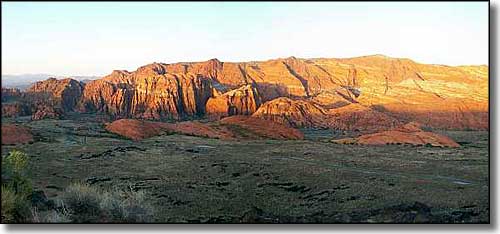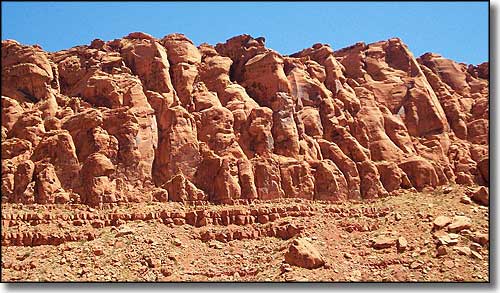
Snow Canyon State Park

Snow Canyon at sunrise
Snow Canyon State Park is named after Erastus and Lorenzo Snow, 2 early Utah LDS Apostles (this is the same Erastus Snow who left his name on the town of Snowflake in Arizona). And in spite of the name, you won't find much snow here. But you will find horseback riding, technical rock climbing, 16 miles of hiking trails, nature studies, wildlife viewing and year round camping in this beautiful but rugged pink, red and white deep-canyon landscape cut with winding sandy washes and interspersed with jumbled piles of black lava rock. From the north, you can see West Canyon and Snow Canyon carving deeply into the sandstone of the Red Mountains as each canyon runs southward, slowly converging and then merging in the center of the park. From that point, Snow Canyon continues on as a single, larger canyon running south-by-southeast. Snow Canyon ends at the south end of the State Park where its mouth opens out onto the Santa Clara bench near Ivins.
Almost 200 million years ago, what is now Utah was buried at the bottom of an up to 2,500' deep sea of quartzite sand dunes. From creamy white to pink to red to burnt orange in color, these quartzite sand dunes were eventually cemented into rock, the Navajo sandstone that we see today. Since that time, water has cut and eroded that sandstone into huge canyons, the softer materials in the stone being removed first. Then came a period of volcanic activity, beginning about 2.5 million years ago and continuing off-and-on until about 20,000 years ago. That filled many of the previous canyons with much harder lava, and forced the ancient waterways to cut themselves some new routes to the ocean. So when you look up at the top of a cliff and see lava there, realize that that used to be the bottom of the canyon.
Snow Canyon is also at the juncture between the Colorado Plateau, the Great Basin Desert and the Mojave Desert. That makes for a wild mix of plants and wildlife. You'll also come across remains left here by Ancestral Puebloan tribes (200 CE to about 1200 CE) and by the Paiute Indians (1200 CE to the mid-1800's, when the Europeans arrived). Hollywood came to Snow Canyon and filmed parts of Jeremiah Johnson, The Electric Horseman and Butch Cassidy and the Sundance Kid using this landscape as a backdrop.
Snow Canyon State Park is a 7,400-acre property as part of the 62,000-acre Red Cliffs National Conservation Area. Red Cliffs National Conservation Area was established to preserve and protect the endangered Mojave desert tortoise and its habitat. Within the area you'll also find peregrine falcons and gila monsters, also on the protected species list. In total, there are 13 sensitive species protected by either state or federal law on this property.
To get to Snow Canyon State Park, go to SR 18 in St. George and head northwest to Snow Canyon Parkway. Turn and go west for about 3.5 miles to Snow Canyon Drive and turn right. The park entrance is right up the road. Snow Canyon State Park is open 365 days a year but the gates are closed daily from 10 PM to 6 AM. Day use costs $6 and camping fees vary between $16 and $20 per night.

Rock formations in Snow Canyon State Park

Snow Canyon State Park area map
